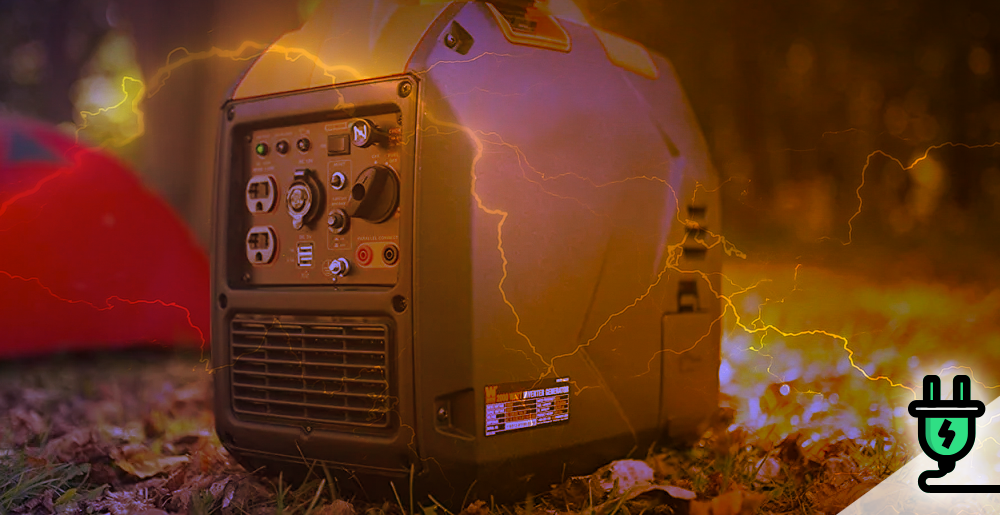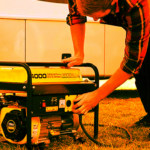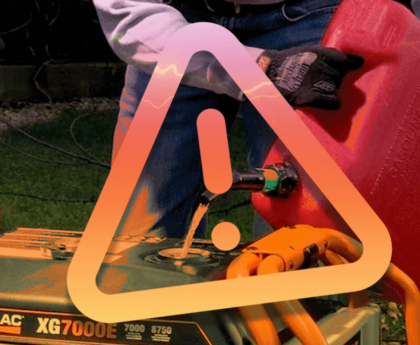Portable Inverters are great if you need power when camping, on vacation or just need an emergency backup. They work by taking the AC power and breaking it down into usable DC that can be stored for later use with lower speeds which make them less noisy as well help keep noise pollution at bay.
Homeowners looking for a quality generator to provide backup power in a storm, natural disaster, or blackout should take a close look at inverter generator technology.
What is an inverter generator you ask? An inverter generator converts the incoming DC power source — whether from an engine powered by fossil fuel, a solar generator or car battery — into AC with help of batteries and alternator.
These portable generators offer a lot of benefits that traditional generators do not.
Many of them are more fuel-efficient, run quieter, and deliver just the right amount of power on demand – all without a lot of the headache and hassle traditional generators can bring to the table.
This isn’t to suggest that inverter generators are without drawbacks, though.
They definitely have a few things that you’ll want to be aware of before you choose them for your backup power needs.
Let’s run through (almost) everything you need to know about inverter generators right now!
How Does an Inverter Generator Work?
Inverter generators operate on the same basic mechanical principles traditional generators work off of, with an internal combustion engine moving a rotating alternator to generate electrical current.
Where they differ, though, is in the kind of power that they deliver.
Inverters work by taking the AC power, breaking it down to DC and then building back up again. These generators have lower speeds which make them less noisy as well as stable so they can better suit your power needs.
The process essentially scrubs the energy supply, resulting in something that’s a lot more consistent, a lot more reliable, and a lot safer to use over longer durations of time.
Pros of Inverter Generators
Fuel Efficient
One of the best things about inverter generators is that they have much higher levels of fuel efficiency.
These generators are able to adjust the speed of the internal combustion engine at the heartbeat of these power plants depending on the power demands required.
Only have a couple of LED light sources hooked up to your generator right now? Inverter generators will run much slower, produce less power, and consume a lot less fuel.
Have all of your major appliances hooked up to an inverter generator in an emergency? This hardware is going to run much faster, produce much more power, and consume more fuel.
The scalability of these generators is a big bonus.
Clean Power
As mentioned earlier, the output you’re going to get from inverter generators is always a lot cleaner. Most inverter generators produce a sine wave output. This is critical when powering sensitive electronics and appliances.
Because traditional generators produce power that is considered “dirty” or that fluctuates, power experts will almost always recommend an inverter generator.
This is going to be a lot better for electronics you have hooked up, it’s going to be much more reliable, and it’s going to allow for parallel capacity (something we highlight in just a minute).
Less Noise
Inverter generators naturally are much quieter than traditional generators, too.
This is especially true when the generator is only running a handful of small electrical components. You’ll be amazed at just how quiet this hardware can be when it isn’t running full bore.
Easy to Maintain
Conventional generators need a lot of upkeep and a lot of maintenance to “stay in the game”, so to speak.
Inverter generators, the other hand, require next to no maintenance without any real degradation in performance. Keep an eye on the battery of an inverter generator and you’re pretty much good to go.
Very Portable
Most of your popular inverter generators are much smaller and lighter and do not have oversized fuel tanks thanks to their improved fuel efficiency. All of this helps to improve portability across the board.
Drawbacks of Inverter Generators
Initial Cost
Upfront costs on inverter generators are (almost always) going to be higher than with traditional generators. You’re paying extra for the inverter technology, the portability, the lower levels of maintenance and upkeep, and all the other benefits this hardware offers.
Lower Power Output Levels
Even the largest inverter generators are generally only going to be able to pump out about 7000 W of electricity. Compare that to some of the portable traditional generators out there capable of pumping out 17,000 W and you can see there’s a bit of a gap in overall power here.
How to Buy the Best Inverter Generator
Finding the right inverter generator becomes a lot easier when you know the core features to zero in on.
Here are a couple of things to think about most when you’re comparing different inverter options on the market today.
Size Matters
Almost all inverter generators are going to be highly portable, with even the biggest options out there weighing in at about 40 pounds or so (right around a large bag of dog food).
At the same time, you might not need the biggest inverter generator in the world to tackle the kind of power problems you anticipate potentially having in the future.
Think about how much power you’re going to need, especially how much power you’re going to need concurrently.
Add up the total wattage demands of all the appliances or electronics you may need to run at the same time in an emergency to find the right size inverter for your needs. Need help finding figuring out wattage requirements? See our post How to find wattage of appliances in 2 easy steps.
Consider Noise Levels
All inverter generators are quieter than traditional options, but some of them are quieter than other inverter choices.
If noise control is important for you (if you’re going to be using this generator out of the woods come in a crowded suburban, etc.) you’ll want to find something that keeps the decibels to a reasonable level even at full power output settings.
Look for Parallel Capabilities
The best inverter generators on the market today have what’s known as “parallel capabilities”.
Inverters can actually be daisy chained with one another, allowing you to combine two different inverter generators with a parallel cable to get twice as much power as you would have separately.
These kinds of capabilities allow you to run multiple inverter generators separately when your power demands are smaller, but also gives you the chance to combine these generators together to create a bit of a “super generator” to run more power-hungry things like air conditioning, for example.
This is a must kind have feature, especially if you think about using inverter generators as a backup option for your home in an emergency.
Understanding the Pros and Cons of Inverter Generators to make a more informed buying decision
Hopefully, this post has helped you understand inverters and their benefits over traditional generators better. Depending on your generator needs, the cleaner energy and smaller packaging of a portable inverter generator may be just what you are looking for.






